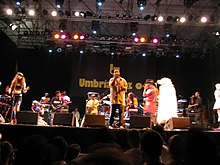
In music, groove is the sense of an effect ("feel") of changing pattern in a propulsive rhythm or sense of "swing". In jazz, it can be felt as a quality of persistently repeated rhythmic units, created by the interaction of the music played by a band's rhythm section (e.g. drums, electric bass or double bass, guitar, and keyboards). Groove is a significant feature of popular music, and can be found in many genres, including salsa, rock, soul, funk, and fusion.

From a broader ethnomusicological perspective, groove has been described as "an unspecifiable but ordered sense of something that is sustained in a distinctive, regular and attractive way, working to draw the listener in."[2] Musicologists and other scholars have analyzed the concept of "groove" since around the 1990s. They have argued that a "groove" is an "understanding of rhythmic patterning" or "feel" and "an intuitive sense" of "a cycle in motion" that emerges from "carefully aligned concurrent rhythmic patterns" that stimulates dancing or foot-tapping on the part of listeners. The concept can be linked to the sorts of ostinatos that generally accompany fusions and dance musics of African derivation (e.g. African-American, Afro-Cuban, Afro-Brazilian, etc.).[2]
The term is often applied to musical performances that make one want to move or dance, and enjoyably "groove" (a word that also has sexual connotations).[2] The expression "in the groove" (as in the jazz standard) was widely used from around 1936 to 1945, at the height of the swing era, to describe top-notch jazz performances. In the 1940s and 1950s, groove commonly came to denote musical "routine, preference, style, [or] source of pleasure."[2]
- ^ Peckman, Jonathan (2007). Picture Yourself Drumming, p. 50. ISBN 1-59863-330-9.
- ^ a b c d Kernfeld, Barry. "Groove (i)". The New Grove Dictionary of Jazz, 2nd ed. (Grove Music Online). Oxford Music Online. Retrieved 16 October 2015.
In the realm of jazz, a persistently repeated pattern. More broadly, Feld (1988), studying groove from an ethnomusicological perspective, defines it cautiously as "an unspecifiable but ordered sense of something that is sustained in a distinctive, regular and attractive way, working to draw the listener in." Connections to dance are important, and the statement that a performance has, or achieves, a groove, usually means that it somehow compels the body to move. Still more generally, the term has a sexual origin and connotation which is obvious, requiring no explanation... Within jazz circles, Gold identifies the phrase "in the groove" – which from around 1936 to 1945 (i.e., during the height of the swing era) was in widespread use in referring to jazz performances which were "excellent" or, by extension, "sophisticated" – and the term "groove" – referring in the 1940s and 1950s to "routine, preference, style, source of pleasure"... Characteristically... [groove] tends to operate with reference to styles from the latter third of the twentieth century which utilize characteristic accompanimental ostinatos drawn from African-derived dance music, whether African-American (e.g., soul, funk, disco, rap, hip-hop), Afro-Cuban dance music (e.g., salsa), or Afro-Brazilian (samba), or some other such fusion.
(subscription required)